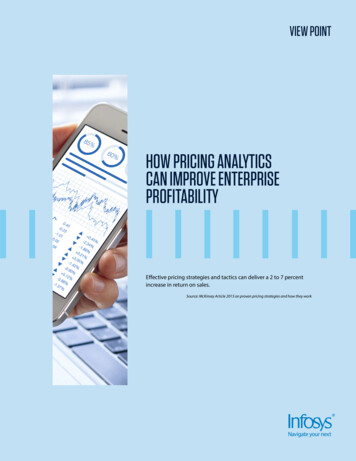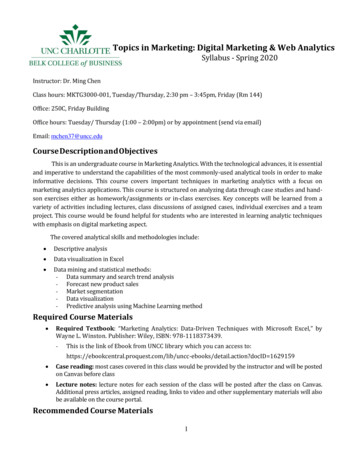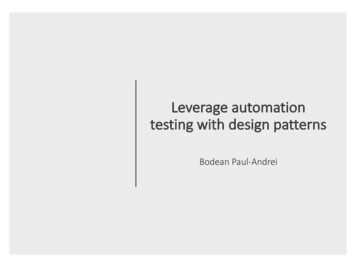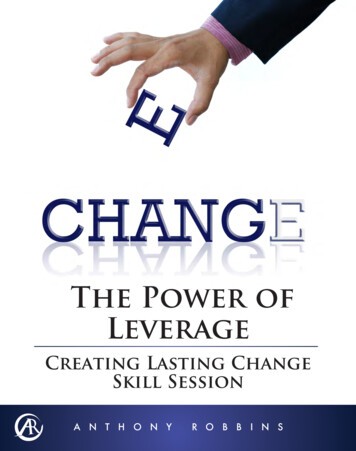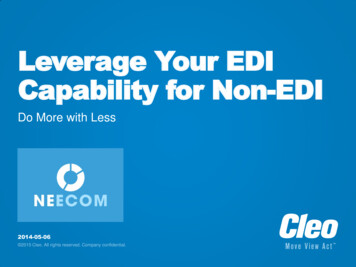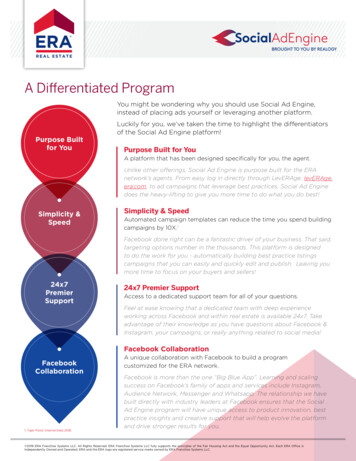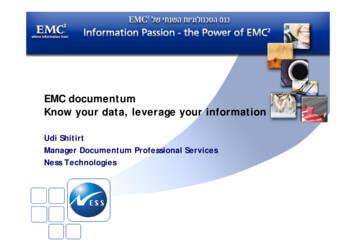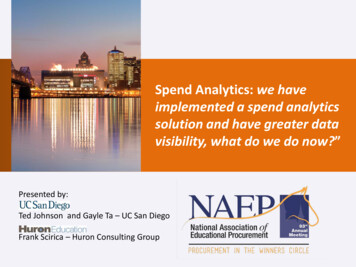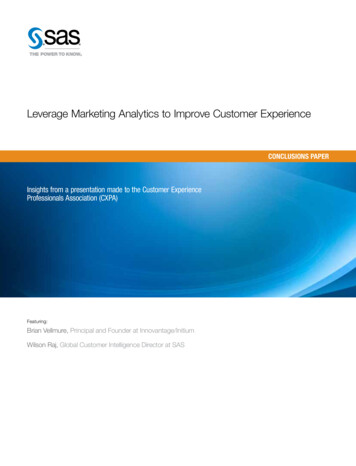
Transcription
Leverage Marketing Analytics to Improve Customer ExperienceCONCLUSIONS PAPERInsights from a presentation made to the Customer ExperienceProfessionals Association (CXPA)Featuring:Brian Vellmure, Principal and Founder at Innovantage/InitiumWilson Raj, Global Customer Intelligence Director at SAS
SAS Conclusions PaperTable of ContentsIntroduction. . . . . . . . . . . . . . . . . . . . . . . . . . . . . . . . . . . . . . . . . . . . . . . 1Keep Up or Lose Out. . . . . . . . . . . . . . . . . . . . . . . . . . . . . . . . . . . . . . . . 1Measuring the Customer’s Journey. . . . . . . . . . . . . . . . . . . . . . . . . . . . 3Focus First on the Big Rocks. . . . . . . . . . . . . . . . . . . . . . . . . . . . . . . . . 4Ask Better Questions, Get Better Answers – withMarketing Analytics. . . . . . . . . . . . . . . . . . . . . . . . . . . . . . . . . . . . . . . 4Using Marketing Analytics to Predict What’s Next . . . . . . . . . . . . . . . 5Marketing Analytics and the Customer Journey . . . . . . . . . . . . . . . . . . 5Putting Marketing Analytics into Action. . . . . . . . . . . . . . . . . . . . . . . . 6Mapping Marketing Analytics to the Customer Life Cycle . . . . . . . . . 7Real-World Success in Applying Marketing Analytics to the CustomerJourney . . . . . . . . . . . . . . . . . . . . . . . . . . . . . . . . . . . . . . . . . . . . . . . . 8A Case Study from the Discover Phase . . . . . . . . . . . . . . . . . . . . . . . . . . . . . . . 9A Case Study from the Explore Phase . . . . . . . . . . . . . . . . . . . . . . . . . . . . . . . . 9A Case Study from the Engage Phase . . . . . . . . . . . . . . . . . . . . . . . . . . . . . . 10View Customer Experience Management in the Right Context. . . . 10How to Orchestrate Marketing Analytics with Your Context . . . . . . 12Final Thoughts. . . . . . . . . . . . . . . . . . . . . . . . . . . . . . . . . . . . . . . . . . . . 13For More Information . . . . . . . . . . . . . . . . . . . . . . . . . . . . . . . . . . . . . . 13
Leverage Marketing Analytics to Improve Customer ExperienceIntroductionHow much do organizations really know about their customers’ experiences today? It’snot enough to just know where customers shop or what brand of jeans they purchase.The key to competitiveness is being able to understand why customers make thechoices they do, how they feel about their choices, and what they experience at eachstep when they engage with your organization. When accurate, that understanding cangive marketers the “holy grail” of being able to predict customer behaviors and positivelymanage customers’ experiences. It’s a goal that is within reach today.Thanks to rapid increases in computer processing power and a multitude of datasources, marketers can find out what time of day their customers prefer to eat theirfavorite meal at a certain fast food restaurant – and what they tell their friends about it.And they have the ability to learn if a customer would rather get an email or a text tofind out about an upcoming sale. They can learn through analysis how certain typesof customers are likely to respond to specific offers, and even how to time thoseoffers and what “catch phrases” to use. And that’s just for starters.The possibilities herald a golden age when customers can expect relevance andpositive experiences, and organizations can align to deliver on those expectationsmore efficiently to create value for all parties. That brighter future will happen soonerthan we expect – but how it plays out is the tricky part.Keep Up or Lose OutToday, the speed of innovation is quickly surpassing the capabilities of traditionalorganizations. And the amount of data that’s being created is soaring in parallel.Just keeping up with it all is a challenge for most organizations. Being able toeffectively analyze all the data is an endeavor most marketers have just begunto address.In today’s competitive environment, it’s vitally important for organizations to be ableto use their data to create an outstanding customer experience, said Brian Vellmureof Innovantage/Initium. Why?“The customer experience is arguably the last remaining bastion of true differentiation,”Vellmure emphasized, because everything else can be quickly and easily duplicated.Only by providing an exceptional customer experience, he said, can companies builda true competitive advantage.How much content is sharedin any given 10 seconds? Eight hours of content isuploaded to YouTube. Almost 8,000 apps aredownloaded from iTunes. More than 114,000 items areshared on Facebook. More than 16,000 posts areshared on Twitter. More than 333,000 searchqueries are sent to Google.1
SAS Conclusions PaperConsider the fact that many large, well-known companies are losing their leadershippositions. The average lifespan of an S&P 500 company 75 years ago was about75 years. The average lifespan of an S&P 500 company today is about 15 years. Atthe current churn rate, 75 to 80 percent of the S&P 500 will be replaced by 2027.1Competitive intensity has more than doubled in the past 40 years – and increasedaccess to information and choices have boosted consumer power to an incrediblyhigh level.The reason all this is happening, said Vellmure, relates to access. Storage, for example,is no longer a gating factor to what we can do. In 1980, a terabyte of disk storage cost 14 million. Today, it costs just 30. Processing power is also readily available. In 1980,the processing power of an iPad 2 cost about 100 million. Today, it’s about 300. Andprocessing power is expected to rise exponentially over the next three or four yearsIt’s shocking to consider the far-reaching effects change and innovation will have on ourfuture. “The pace of innovation over the next 10 years will be similar to the last 100,” saidVellmure. “The rate of change over the next 25 to 30 years at its current trajectory will besimilar to the previous 1,000 years. That’s mind-blowing.”Fast-paced trends like these have led to an environment Vellmure calls “microeverything.” Through greater access to technologies and tremendous processingcapabilities, he said, we can measure virtually everything at a highly granular level. Wherewe go, what we look at, who we know and what we say can be measured. Down theroad, even what we think and what’s happening inside our bodies might be measured.The audience was asked about marketing analytics (“analytics” for short) and how theyuse it to improve the customer experience. Sixty-five percent rated themselves as “early”or “basic,” so there is room to ericafinal2012.pdf“The pace of innovation over thenext 10 years will be similar tothe last 100. The rate of changeover the next 25 to 30 yearsat its current trajectory will besimilar to the previous 1,000years. That’s mind-blowing.”Brian VellmurePrincipal and Founder atInnovantage/Initium
Leverage Marketing Analytics to Improve Customer ExperienceAudience Poll 1How would you rate your organization’s maturity in using analytics to improvethe customer %40%50% Early. We’re just beginning our journey. Basic. We’re using basic analytics on customer data (e.g., customer interactions/transaction data); and we review reports quarterly/annually. Advanced. We’ve consolidated a near-real-time dashboard of multiple sourcesof internal and external data, and we use it to adjust/respond to customerpreferences on at least a quarterly basis. Cutting edge. We’re using real-time analytics on structured and unstructureddata across most channels to dynamically influence our customer interactionsand offers in near-real time.Measuring the Customer’s JourneyAs a marketer, Vellmure stressed, the ability to understand and measure yourcustomer’s journey at every touch point across multiple channels is core to yoursuccess. Because if you can’t measure the journey in terms of revenue and profit,you’ll have no idea of where you are, how you’re perceived or how to improve – andyou’ll end up on a rapid downhill spin.Historically, most companies have used structured data to map out and inform thisunderstanding. That approach has typically included demographic, transactional andlog data, email data and event data. But today there are many types of emergingdata sets to help you learn about your customer’s journey: social media, video, RFID,sensor data, geolocation data, audio, image data and external structured data. Thesenew data sets can help you see more clearly what the customer’s journey looked like,where they came from, where they’re going and which points within theirjourney actually made a difference.3
SAS Conclusions PaperAudience Poll 2If you could gain access to and merge your existing data with just one of thefollowing data sources by the end of the year, which would you choose?DEFGACBA.B.C.D.E.F.G.H.I.Social media. 28%External structured data. 28%Other digital unstructured data. 24%Geo-location data. 8%RFID data. 4%Audio data. 4%Video data. 4%Sensor data. 0%Image data. 0%Focus First on the Big RocksEven with the surge of available data, the fundamental things you need to know aboutyour customers still come from the structured data in your core systems. You couldcompare structured data with big rocks, Vellmure said.Think about filling a jar with rocks. To get everything in the jar, you need to add your bigrocks (your core data) first – and then fill in around it with the small rocks (newer datatypes, like social media, video or sensor data).The role of the small rocks, said Vellmure – which represent big data – is simply toaugment your core data set by providing added texture and color. While the new datacan expand your understanding of customers, unveiling new insights and delivering a“wow” factor, it can never replace the fundamentals.Ask Better Questions, Get Better Answers – withMarketing AnalyticsThere’s such an abundance of data at our fingertips today that it raises the question:“What are we going to do with it all?” People don’t have the capacity to sort through allthe data that’s available today, said Vellmure. And a lot of it is garbage anyway – it’s notvaluable in any way.Fortunately, you don’t need more data to improve your marketing efforts. You just needgood data that can help you get better answers to important questions so you candiscover new patterns and generate new insights. This is where technology can help.4Focus on the Big RocksSmall data Big rocks.Core customer information isthe foundation.Big data Small rocks.New types of information augmentyour fundamental data set.
Leverage Marketing Analytics to Improve Customer ExperienceMarketing analytics can pull out the right information and lead you to the right insights.As you apply analytics to the customer journey, the results can help you see whichpeople are influential hubs in the network. It can show where groups are forming aroundcontent or people, and whether there are any correlations that might lead to product orservice innovations, etc.Using analytics to analyze traditional, structured data in conjunction with newer typesof data, you can: Learn how to improve the customer experience at specific touch points.“We have the ability to askquestions that we’ve never hadthe ability to ask before. And byasking better questions, we canfind better answers.”Brian VellmurePrincipal and Founder atInnovantage/Initium Understand the main things your customers want you to do for them – primarily,to accomplish what they’re trying to do and to help them feel good. Make better decisions – faster.Through good data and analytics, said Vellmure, “We have the ability to ask questionsthat we’ve never had the ability to ask before. And by asking better questions, we canfind better answers. We’re not relegated to just finding just the answers that are sittingthere in our emails or in our ERP, CRM or transactional systems.”This new world of analytics and unstructured data give us the capability to discover newpatterns and garner new and deeper insights. When we go to the moon, Vellmure said,we don’t necessarily go there to solve a specific problem. We go there to discover newfrontiers that we didn’t know were possible before. The same is true with analytics.Using Marketing Analytics to Predict What’s NextThe next big step with analytics, Vellmure said, is to predict what’s going to happendown the road. Consider the popularity of predictive algorithms. Amazon, for example,does a great job of telling you what books or content you might be interested in buying,based on your previous behavior.But the results of predictive analytics aren’t always what we expect. Someone recentlyasked: “What’s a good predictor of future major league success in football?” Mostpeople would expect a player’s skill set and performance in college to be good gaugeof future success in the major leagues. But analytics showed that where a person grewup was actually a better predictor.Marketing analytics enablesyou to: Ask better questions. Find better answers. Discover new patterns. Generate new insights. Make better decisions.Marketing Analytics and the Customer JourneyIn the world of marketing, predictive analytics allows you to ask: What’s my customer’sjourney as it transcends different channels? What contributed to her actions, and howmuch, in terms of each touch point?Predictive analytics can help you understand who people are connected to on the socialWeb, what they’re sharing, and what infl
Cutting edge. We’re using real-time analytics on structured and unstructured data across most channels to dynamically influence our customer interactions and offers in near-real time . Measuring the Customer’s Journey As a marketer, Vellmure stressed, the ability to understand and measure your
